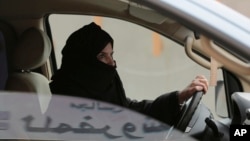Saudi Arabia’s decision to lift its ban on women driving cars may help to restore sales growth in an auto market dented by the economic fallout from weak oil prices, handing an opportunity to importers of luxury cars and sport utility vehicles.
Carmakers joined governments in welcoming the order by Saudi Arabia’s King Salman that new rules allowing women to drive be drawn up within 30 days and implemented by June 2018, removing a stain on the country’s international image.
“Congratulations to all Saudi women who will now be able to drive,” Nissan said in a Twitter post depicting a license plate bearing the registration “2018 GRL.” BMW, whose X5 SUV is the group’s Middle East top-seller, also saluted the move.
WATCH: Activists: Driving Augurs Further Expansion of Saudi Women's Rights
Midrange brands dominate the Saudi market, with Toyota, Hyundai-Kia and Nissan together commanding a 71 percent share of sales.
Market had shrunk
That market has shrunk by about a quarter from a peak of 858,000 light vehicles in 2015 to an expected 644,000 this year, reflecting the broader economic slowdown. But the rule change adds almost 9 million potential drivers, including 2.7 million resident non-Saudi women, Merrill Lynch has calculated.
“We expect demand to rise again on news that women will be allowed to drive,” said a senior executive at Jeddah-based auto distributor Naghi Motors, whose brand portfolio includes BMW, Mini, Hyundai, Rolls Royce and Jaguar Land Rover models.
The arrival of women drivers could lift Saudi car sales by 15-20 percent annually, leading forecaster LMC Automotive predicts, as the kingdom’s “car density” of 220 vehicles per 1,000 adults rises to about 300 in 2025, closing the gap with the neighboring United Arab Emirates.
A middle- to upper-class Saudi family typically has two vehicles, one driven by the man of the house and a second car in which a full-time chauffeur transports his wife and children.
The rule change could spell bad news for some of the 1.3 million men employed as chauffeurs in the kingdom, including a large share of its migrant workforce, while boosting upscale car sales as households upgrade for their new drivers.
Entire market likely to benefit
“The move to allow women to drive is set to benefit the entire market,” LMC analyst David Oakley said. “But we might expect to see a disproportionately positive impact on super-premium brands.”
Luxury brands including Lamborghini and Bentley are about to launch SUVs, a vehicle category that has proved popular among women and accounts for more than 1 in 5 cars sold in Saudi Arabia.
Welcoming the announcement, British-based Aston Martin said it was well timed for the arrival of the James Bond-associated sports car maker’s DBX model, due in 2019.
“The SUV crossover boom across all segments has been powered by women,” spokesman Simon Sproule said.










